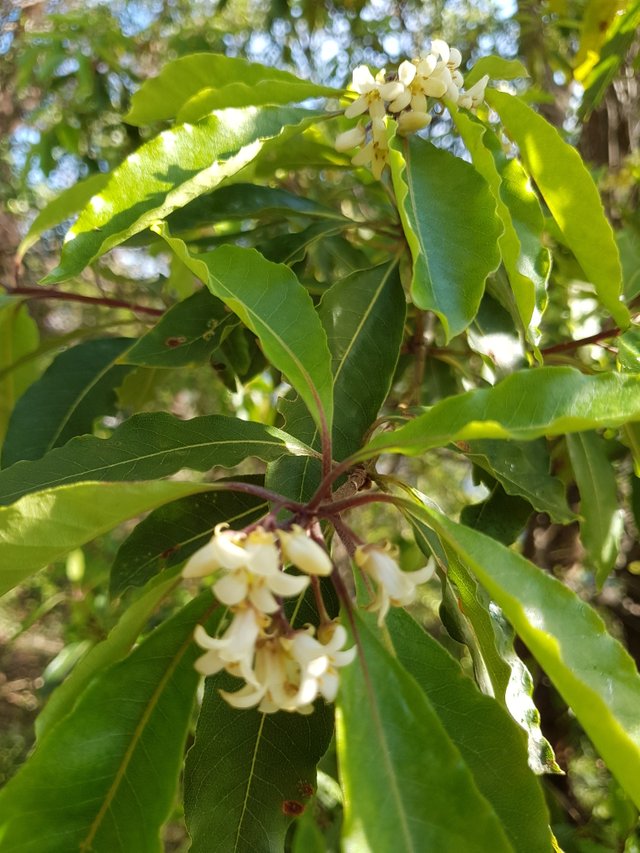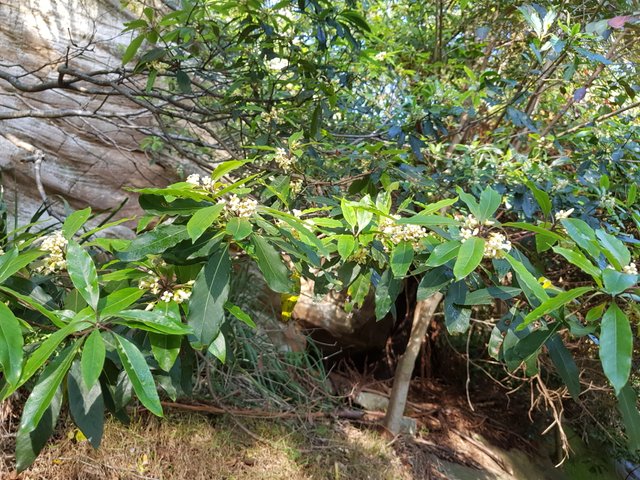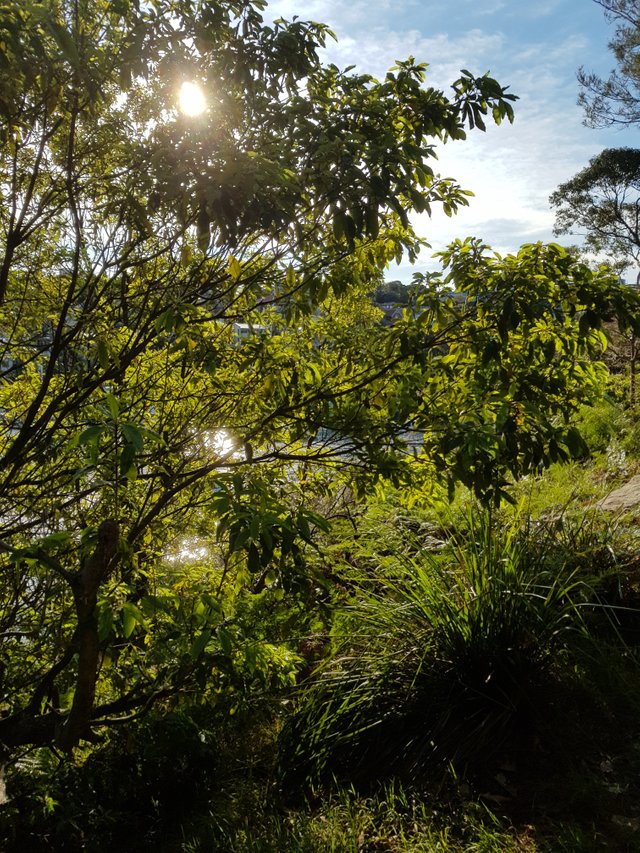Native Laurel, if only all weeds were this good
Pittossporum undulatum is a fast growing evergreen tree, called by it's various common names Native Laurel, Native Daphne, Mock Orange and Sweet Pittosporum. This plant is native to Australia and it's natural habitat is in Rainforests and wet sclerophyll forests ( forests with higher rainfall ). Birds eat the berries, and deposit them where they travel, and this leads to the plants growing in areas that it is not neccessarily welcome. Other species of Pittosporum are not considered weeds and are popular garden plants.
This native Pittosporum is an attractive plant, with shiny glossy green leaves and has masses of small creamy- white flowers with a wonderful fragrance. The scent of the flowers is a delight while walking amongst stands of the tree in parks and reserves, so in my opinion, this is a plant which maybe attracts undeserving criticism, and there are many other introduced weeds that present far more of a threat to native bushland.
Native Laurel is happy growing in semi-shade under taller trees as well as out in the open sun by itself or as part of a mixed planting. it flowers in Spring and early summer, and is drought tolerant once established, but does benefit from an extra watering. Left unpruned, it can grow to around 10 to 12 metres tall, so if you have a large garden , it could be considered, or maybe you will get some plants growing, courtesy of local birds if you live in Australia.
I took these photos in a local Reserve where i regularly take a walk.


Pittosporum undulatum is a tree to 12 metres in its natural habitat but usually smaller in cultivation. It provides dense shade and spreads up to 7 metres across. It has coarse grey bark and glossy green elliptical leaves some 6-15 cm long and 1.5-4 cm wide with distinctive wavy, or undulating margins. The leaves are about 75 mm long with toothed margins. Small, white, fragrant flowers occur in terminal clusters in spring and early summer and are followed by orange-tan berries 1 cm in diameter in autumn, which persist for several months.
The species is well established in cultivation in Australia and some other warm regions around the world such as California. It is a hardy and adaptable plant which appreciates most acidic soils and extra moisture, yet can also withstand extended dry periods once established. It can be clipped into hedges and is quick growing, as well as having pleasantly perfumed flowers which can pervade a large area (hence the common name 'native daphne').
http://anpsa.org.au/p-und.html
Fav. comment Award ! Great Pics and information.
Pittosporum undulatum, known as Sweet Pittosporum or simply Pittosporum, is a small tree native to certain moist forests and woodlands on fertile soils on the coast and nearby ranges in southeastern Australia. Its natural range extends from southern Queensland to eastern Victoria. At the western end of its range it was recorded “in rocky places about Western Port” by Mueller in 1860. In recent years, concern about its spread particularly in Victoria has seen it branded nationally as an “environmental weed”. In Sydney however, calling it a weed puts at risk scarce remnants of vegetation where it is native.
Around Sydney, Pittosporum undulatum occurs naturally in widespread sandstone gully habitats, and in the understorey of two rare vegetation types, Blue Gum High Forest (BGHF) and Sydney Turpentine Ironbark Forest (STIF). Each type of forest has been reduced to about 1% of its former extent, much of which persists as small patches on edges of privately-owned farmland. Each forest type has been gazetted an Endangered Ecological Community (EEC) under the NSW Threatened
Species Conservation Act 1995. Compare the maps of Sydney’s Natural vegetation 1788 and 1990 – almost all the aqua blue and khaki green indicating these EECs in eastern Sydney has disappeared
Pittosporum undulatum has been branded an “environmental weed” and literature with this message distributed nationally. The ESA Bulletin of December 2000 contained a thesis summary entitled “The ecology of Pittosporum undulatum …. an environmental weed in southeast Australia”. The message members of the general public receive from the term “environmental weed” is that Pittosporum’s a weed that’s bad for the environment, and should be eliminated! If they see it growing, even in scarce remnants of its native habitat, they may bulldoze the whole understorey and all its associated biodiversity. This is what happened to convert forest
References1234
Silly Sausage Award ! Well done on your choice of Pics and information.
Thank you so much!
@ctrl-alt-nwo,
Is that the harbor walking path? It seems like a little forest! Never heard about this plant before! Honestly I don't want to plant it at my garden! But I like the description that you shared with us!
Cheers~
Yes it's the same path again. There's something different every time i go there.
I never seen Laurel shrub before but its leaves we use for a dish called Adobo and Menudo @ctrl-alt-nwo and it does makes the dishes fragrant.
Yeah, i like Adobo, had it a number of times when i was in Phil.
Excellent messages and regular information about the plants.
The Pittosporaceae family includes woody plants originating from Oceania, East Asia and tropical Africa, very similar to the Saxifragaceae, but different from them mainly due to the presence in the cortex of the resin channels and the corolla structure, which can be gamopetala. Flowers are usually attinomorphic, hermaphroditic, with perianth, usually consisting of 5 more or less grown sepals and as many petals, sometimes welded, androceo pentamero, gyneceo of 2 fruits forming ovario-supero. The flower formula is usually as follows:
A fruit is a capsule or lizard of a polysperm (Ribes).
The most famous species is Pittosporum tobira, a shrub with leather leaves, evergreen, brilliant and fragrant flowers, widely used for hedges and borders in gardens, especially in coastal areas with a mild climate.
http://www.dipbot.unict.it/sistematica/Pitt_fam.html
Pittosporum undulatum (Victorian Box) - A large shrub or medium sized tree that can reach to 30-40 feet tall or more with a pyramidal shape but is most often seen maintained as a much lower screen or hedge plant. Attractive dark green leaves have very wavy margins and the fragrant cream-white flowers bloom in profusion in the early spring. Following bloom, small orange berries are produced, which can be a nuisance but also attract birds. Plant in sun or part shade and give deep and infrequent watering – older plants are quite drought tolerant. Established plants hardy to at least 18° F. This is an extremely useful plant as a large attractive hedge and windbreak. We have been told that warblers and mockingbirds are attracted to the fruit and Anna's Hummingbirds to the nectar of the flowers.
Source: https://www.smgrowers.com/products/plants/plantdisplay.asp?plant_id=1291
These are amazing weeds growing up ti12 meters as high as tree storey buildings!
If the leaves or flowers could be used in cooking or salad, this would become very useful and popular in my country!
Posted using Partiko iOS
they look excellent beautiful shots you shared and great to know in depth about it :)